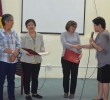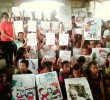AN EXECUTIVE SUMMARY
Center for Women’s Resources
March 2014
Throughout the world, the Philippines has been regarded as one of the best place for women, based from the results of the 2013 Global Gender Gap Index. The Philippines ranked 5th, three levels higher than in 2012 and highest in the Asia Pacific. It even surpassed many developed countries such as United Kingdom, Canada, France and the United States.
Alongside with this, the Aquino government boasts of the rising econonomy, the 7.2% growth in the gross domestic product (GDP), using as basis the 33% increase in foreign domestic investments and the Philippine stock exchange reaching its all time high record. President Benigno Simeon (BS) Aquino attributes this growth to his good governance in line with the slogan “matuwid na daan”. He assures the Filipino people of the inclusiveness of growth because it is in the core value of his programs.
However, the majority of the Filipino women consider such “inclusive growth” as elusive since despite the declaration of growth, they still experience unemployment, price surges, lack of social services, and disasters that aggravate the violence they experience everyday.
Such condition of women is the effect of the Aquino government’s adherence to the neoliberal framework of development that favors the local and foreign businesses over national interest. So despite ranking fifth in the latest Global Gender Gap Index, Filipino women still bear the brunt of exploitation and oppression due to the following factors:
“ Inclusive growth” for the rich
Filipino women, along with the rest of the people do not feel the inclusiveness of growth when poverty incidence remain high at 25.2%. Despite having an expensive poverty reduction program like 4Ps, poverty incidence did not significantly change from 26.6% in 2006. Conservative estimation gives us 23.7 million poor Filipinos, highest incidence were recorded in ARMM, Eastern Visayas, Central Visayas, Bicol and CARAGA.
To cope with hunger, poor families have lessened their food intake and have developed terms to cope with hunger, such as the following:
Memorize or Imagine – families visualize delicious and nutritious food while eating rice with salt or fish sauce
Practice – families adjust and reduce their food intake in anticipation of a decreasing supply of food in the coming days
“Peking duck” – a new term for “pagpag” (dusting off), referring to leftovers from restaurants, which families collect from the garbage and cook as their meal for the day
AlTangHap – eating one full meal for a day, already covering almusal (breakfast), tanghalian (lunch), and hapunan (dinner).
Piso-piso – junk food, which costs ₱1.00, serves as viand for poor families
Joblessness is still a perennial problem in despite the rising economy. Unemployment rate is at 6.5% in October 2013, underemployment was 17.9%. More than one million Filipino women were unemployed. There remains a huge gap in the labor participation rate among men and women. In 2013, about 9.5 million women were considered not part of the labor force.
For those who were able to get a job, most of them (35%) are laborers and unskilled workers earning an average wage of ₱150.00. About 16% are service workers, also with a low wage of about ₱200.00. Worse, government statistics even count as employed 2.3 million women who areunpaid family workers. Massive contractualization and the two-tiered wage policy worsen the situation of women workers.
Peasant women who comprise the majority of Filipino women, carry the burden of the long-standing issue of landlessness and the dwindling government support for agriculture. Seven out of ten peasant families still do not have their own land to till. Landlessness and landgrabbing forces many of them to work in agricultural plantations, mostly foreign-owned where they get an average basic pay of ₱148.00. Women farmworkers also get, at the average, 15% lower basic pay than men. While the government opens up the industry to global trade and lessens its support in agriculture, the livelihood of rural families dwindles.
Poverty caused by landlessness and lack of decent jobs force many women to work abroad. Based from POEA data, in 2012, an average of 683 Filipino women were deployed daily to work in other countries. Most of them are in services (76%), working as domestic helpers, cleaners or cooks – jobs that are vulnerable to abuses due to the private nature of their work.
While the Filipino women are largely excluded in the so called-inclusive economic growth, the economy is very favorable and accomodating to local and foreign businesses. The net income of the 50 richest families in the Philippines is equivalent to 25% of the country’s GDP. The railroading of charter change in congress to further liberalize the economy will give more way to foreign market interests and big local businessmen.
Surging prices of commodities and services
The uncontrollable price increase due to liberalization and deregulation adds burden to women who usually budget the family’s meager income.
Rice, the Filipinos’ staple food, has increased by ₱2.00 to ₱8.00 for every kilo. As discussed earlier, dire poverty forced poor families to change their eating lifestyles. They have nothing to eat but rice and salts, fishsauce or salty junk foods. Thus, the increase in the price of rice is a huge burden for them.
LPG, an important utility used by women, has increased its price by ₱100.00 to ₱180.00 per 11-kg tank. Prices in Metro Manila rose from ₱700.00 in 2012 to more than ₱900.00 in 2013. Higher prices were recorded in Mindanao and the Visayas even before the typhoon Yolanda lashed Eastern Visayas.
The deregulation of the oil industry caused the vulnerability of oil prices to spike up and down, though most of the time, it goes up. For example, in 2013, CWR monitored that the price of diesel increased 23 times while it decreased only 16 times. This resulted to the net increase in the price of diesel by ₱4.68.
Water, electricity, and fare in MRT and LRT are subject to increase. Water rates will increase by 21% to 30%. Power has been steadily increasing since the implementation of EPIRA in 2001. The latest proposal of Meralco – the top grosser company in the country – is to add ₱4.25 per kWh in its rate, citing losses and necessary improvements as reasons for the increase. The MRT/ LRT fare proposes 25% to 67% hike. These proposed rate hikes in water, electricity, and MRT/LRT fare are only restrained temporarily by the massive assertion and resistance by the people.
Corruption eats up services for the people
The latest news on corruption, the ₱10-billion PDAF (Priority Development Assistance Fund) scam involving Janel Napoles and a number of senators and congressmen, further deprived women and their families the necessary social services. The public’s rage has forced Pres. Aquino to modify the concept of PDAF and while he strongly defended the presidential funds that are disposed at his discretion.
Aside from PDAF, there are numerous corruption issues that haunted Pres. BS Aquino, such as: (1) technical smuggling in import products such as rice, onions, meat and oil; (2) the extortion cases involving presidential sister Ballsy Aquino; (3) huge bonuses for top officials of government-owned and controlled corporations (GOCCs) such as SSS and Philhealth, (4) the misuse of disaster funds, and (5) the disbursement acceleration program (DAP), which was said to be used to bribe senators in the Corona impeachment.
As the corruption charges pile up, the people realized that the country has enough money to supposedly provide social services. That is why, the government’s claim of few resources to deliver affordable and efficient services is unacceptable. With enough money, women could not see the reason why the government needs to resort to partner with private corporations through public-private partnership (PPP) programs.
Profit before service
Several contracts in social services has already been awarded to the private sector, for example the Megawide-BF Construction in PPP in School Building program. Real estate companies are also encouraged to build “low cost” housing units in exchange of several tax incentives. There is also the looming privatization of all the 72 DoH-run hospitals, including Fabella maternity hospital. Surely, with the private sector handling the services, profit will be considered more than service.
The supposedly “inclusive budget” indicates only the same priorities of the government. Debt servicing still eats a large chunk of the people’s budget. Budget for defense is also huge, which is 40% higher than the budget for health.
Education budget increased by 14.9% from ₱293.3 billion to ₱336.9 billion. Still, the budget is only 2.3% of the country’s GDP, way below the UNESCO recommendation. It still lags behind neighboring countries in Southeast Asia such as Indonesia, Malaysia, Thailand, and Viet Nam which allots an average of 4.1% equivalent of GDP in education. Further, the budget increased but not the salary of teachers and non-teaching personnel who are mostly women. A portion of the budget, some P15 billion will be for the construction of 15,619 classrooms. Such construction is not to address the backlogs in classrooms but for the expected senior high school students for 2016 because of the K+12 program. The K+12 program has long been opposed by students and parents because it is an additional economic burden to families. Also, K+12 program will only produce cheap labor to serve the market intests of local and foreign businesses.
The ₱10.2 billion budget for housing is for the relocation, tantamount to demolition of 26,367 informal settler families in “danger areas” especially those located along the waterways in Metro Manila.
Government neglect, unpreparedness and militarist response in times of disaster
Filipino women faced a number of crises in 2013 that remains unanswered – the crisis in Sabah, Zamboanga siege and massive militarization, massive floods in Central Luzon and Mindanao, earthquakes in Bohol and Cebu, among others. But the most glaring disaster that caught international concern was the effect of Supertyphoon Haiyan/ Yolanda.
The effect was glaring because of the neglect, unpreparedness, and militarist response by Pres. BS Aquino. More than 6,200 were dead and 28,00 were injured. More than 1,000 are still missing. Two to three bodies are still found everyday. Many of the victims are women and children. Almost 80% of Eastern Visayas have been completely devastated.
Haiyan/ Yolanda survivors recounted that instead of bringing food and medicines right after the typhoon, the government deployed many police and military purportedly to “keep peace and order”. The US government likewise deployed 13,000 US servicemen to conduct “humanitarian relief mission”. Sadly, the disaster became the reason for a smoother military deployment in the region. It is well known that there is ongoing talks with the increased rotational presence of US troops in the Philippines in line with the strategic US Pivot in Asia-Pacific.
Rescue and relief was very slow despite the pouring of local and international aid. The planned rehabilitation was offered to 18 big companies, which divided the region like a pie. Eastern Visayas was promoted as open-for-business for the Aquino’s PPP program.
Intensified crises result to intensified violence
While women face these crises, they also experience different forms of violence. At least 45 cases of domestic violence are being recorded daily. This is 43% higher than in 2012. This means that one woman is beaten every 31 minutes.
Reported cases of rape also increased by 24% from 5,180 in 2012 to 6,432 in 2013. This translates to one woman or child raped every hour and 21 minutes, where 75% of the victims were children.
Different forms of harassment have also been experienced by women and children. There is one woman or child being harassed every two hours and 25 minutes.
Trafficking cases were also recorded. With the devastation in Eastern Visayas and with the slow government response to the needs of the people, many women have been lured by illegal recruiters to work in the cities. By nature, women tend to look for means to feed their families that is why they are more vulnerable to illegal recruitment and trafficking.
With the intensified crisis and violence, comes the resistance from women and the people. The state answers such assertion with repression and human rights violations. There have been 152 victims of extrajudicial killings under the Aquino administration, 18 of them were women. Some of those who fight against anti-people policies are harassed and detained. As of August last year, there have been 34 women political prisoners in various jails in the country.
Assertion may result to repression. But such repression will result to more assertion from the people who desire for a transformed society, for a better Philippines. Women are a major force in making the transformation of society a reality.
For reference, contact:
Cham Perez, 09156531122 | (02)4112796
website: www.cwrweb.org
IMPORTANT NOTICE: INBOX is an archive of press releases, statements, announcements, letters to the editors, and manifestos sent to Davao Today for publication. Please email your materials to davaotoday@gmail.com. Davao Today is not responsible for the content of these materials. The opinion expessed in these items does not reflect those of Davao Today and its staff. Please refer to our terms of use/disclaimer.










